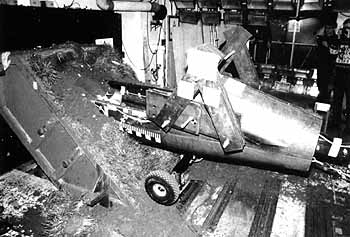The following Article was published in the Aero Intern magazine.
It is due to the friendly permission from the magazine that we are able to reprint the article.
Accidents and fatalities and the repercussions thereof, with gliders or motor gliders are seen as very regrettable by most sport pilots, however it is accepted as fate. This article shows that many things are being done to influence fate to some degree.
Preparation
The atmosphere was tense among the people on hand at the crash site at TUEV-Rhineland in Cologne. The time is drawing closer for the third practical test at the beginning of January 1998. The Transportation Ministry is the client for these tests, the Air Transport Ministry initiated and follows the tests, the TUEV has the order to investigate. Hundreds of accident reports were studied to find re-occurring damages or construction weak points that could be corrected.
It is supposed to show that all the thoughts and calculations were correct and the effort was worthwhile. Engineer Helmut Fendt from the LBA and engineer Martin Sperber as project manager from TUEV must constantly answer media questions concerning technology and the safety standards in the glider construction, and to shed light on the reasons for these tests.
In the mean while all measuring points have been repeatedly inspected. The lights and the speedometer both work reliably, pictures are being taken from all sides. The incorruptible high speed cameras are standing in position. Here a crash is being simulated at 45 degrees and 70 km/h onto a grass underground.
The new construction methods
The all black test fuselage is mounted on a frame. The darker color shows that other, newer materials have been used. Large steel weights are mounted in place of the wings to compensate for the 525 kg, which is considered to be the standard flight weight of a standard class glider.
The fuselage or more exactly the front part of the fuselage of a glass wing hornet is put together up to a half meter behind the beginning of the wings. The manufacturer Glasfaser Flugzeugbau Jörg Streifeneder, in Grabenstetten built this one of a kind glider in the original form. This way a neutral glider was made available. One which is no longer being produced, but still has a modern interpretation of a cockpit.
By the hybrid construction , carbon fiber and Dyneema fabric was soaked in Epoxy hardener. The layers of cloth must be carefully thought out. New methods of gluing had to be developed, because this material can not be as easily preserved as GFK parts. We looked over the fence of our colleagues of the Formula one racing. This hybrid construction method is been used with great success in the car racing scene. The new materials have proven themselves on the many occasions, in the most incredible crashes.
The Crash
The testing area must be cleared, everyone must stand behind a safety fence. Warning lights flash and a sirens sounds alarm, the countdown begins.
By zero an increasingly loud rolling noise can be heard. The fuselage rolls toward a container filled with dirt and grass. Two meters before contact with the container the drive chain is released. The fuselage with the large steel weights drills itself with a loud bang deeply into the dirt filled container. Dirt flies everywhere, the impact is so intense that a neon light was knocked out my the flying dirt.
The speedometer shows exactly 70 km/h, everything is quiet. An amazing result remains: In the exact position where the pilot usually sits, almost nothing happened! The feet were pushed back approximately 20 cm, and that is all. By a crash landing with the new cockpit the pilot would have had an almost completely intact seating area. That is incredible, because the pictures of past test crashes and past experience in a fiberglass fuselage paint a drastically different picture. With a fiberglass fuselage under the same test situation, you could only assume where the cockpit would be.
Result

During that test, a steel bar marked the fuselage after it plunged 130 cm into the earth, otherwise there was no other larger damage to be seen. A fiberglass fuselage as built nowadays only manages to dent the earth surface approx. 13 cm before it breaks apart.
The lighter version of the fuselage from May has a thickness of only 1.5 cm and has a weight of 2 kg less than a fiberglass fuselage.
Regardless of the original concerns, the experts came to the conclusion that with a correct seat belt position and a sturdy headrest the pilot would have a very good chance of surviving the crash!! The middle G force due to the delay was approx. 16.5 G.
For comparison: The Automobile industry perform crash tests at a speed of 50 to 56 km/h, with 30 to 35 g. This is considered to be survivable with a correct back support. The so often ludicrous debris, with mangled passenger cell after a crash even with a large crumple area to absorb the energy is well known to everyone. A hybrid cockpit is a survival area from a different world.
The reasons for the test
Throughout the European Union alone, there are over 20,000 gliders and motor gliders registered. Over 60,000 pilots are holders of valid pilot licenses. This gives the need to develop a reliable protection for a large number of pilots and co-pilots. The TUEV Rhineland conducted the first open air tests back in 1987.
Dr. Anthony M. Segal crashed in England in October of 1988 on his own costs.
The fuselage was a “Standard Libelle”. Mr. Segal was present during the tests in Cologne. He was very satisfied and happy that the test results pertaining to the research efforts turned out so positively.
After all he was one of the first to pave the way for intensive safety studies on gliders! The pictures back then showed shocking results for the fiberglass construction industry. One could hardly speak about passenger protection.
Pilots who have witnessed a crash or themselves survived one, can verify this statement. The safety considerations in the past for a hard ground contact were hardly taken into account by the construction of the cockpit. No one knew any better at that time, not to mention that things were changing. However new standards are now being set, and all new developments must meet these higher standards.
The pilot of a glider sits exactly in the same area where the crunch zone of a car is located. To put it more dramatically, the pilot of a glider is the crunch zone.
The Fact Is:
Accident statistics for gliders and motor gliders show that the reasons for a majority of the accidents occurred to approx. 80% In lower altitudes. In 1997 there were 22 deaths and 34 seriously injured during the operation of gliders and motor gliders licensed in Germany. The pilots were left with little or no time and not enough altitude to eject with their parachute. A rescue system with a parachute like the type used today would not have helped much because the time required for the chute to open is too long!
The author of the report saw wrecks of 6 fiberglass glider crashes. Three crashes as an eye witness. All six pilots lost their lives. Five of the pilots however could have survived their low altitude , low speed crashes, with little or no injuries had they been sitting in a hybrid cockpit.
Combining and Optimizing:
There are rescue systems being developed in the Aachen University of Applied Sciences that take into account the time required by the parachute before opening. However a combination of a safety cockpit and an improved pilot rescue system is probably the best solution. Especially when the added costs of a safety cockpit (approx. Euro 3.000,00) is within a reasonable price range. There are no additional installations necessary with the hybrid construction method. A lot can be obtained simply with a sturdy seat belt, that reaches under the edge of the canopy up to the tip of the fuselage. Optimizing the form of existing parts – like the spant for the control stick or the landing gear compartment – is enough to obtain incredible results.
The members of TUEV and the LBA will continue to work on improving the details. At the least a small crunch zone in front of a under the pilot should be developed, because not all of the accidents involved the glider hitting the ground nose first. Shock absorbing components for the seat pan are being developed. Things that appear simple can avoid worse things from happening: Correctly fastening the seat belt, making sure that the lap belt is in correct position is very important. The lap belt must be tightly fastened, the shoulder strap must not be so tightly fastened. A five point seat belt is a disadvantage , because the extreme force of the pilot sliding forward can cause soft tissue damage. Thicker and softer pillows cause more harm than no pillow at all!! A good headrest, one that deserves the good rating is a must in any glider. Even things like that are taken into inspection by the BMV and TUEV during crash tests.
The Customer Decides
The members of TUEV and the LBA wants and will work to maximize the potential of the hybrid construction method. Never the less, the future of the safer glider construction has begun. The safety construction method will quickly become a success if the buyers of gliders and motor gliders request it from the manufactures taking into account the slightly higher costs. A navigation computer is much more expensive than the added costs of a hybrid constructed glider. When the results of the tests in the European Construction regulations JAR 22 take affect, which is expected to happen the added costs will fall.
However for the price of personal safety, I would not wait that long!
Alfred Lüdemann
translated by Barry Heinrich, DG
